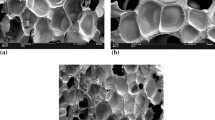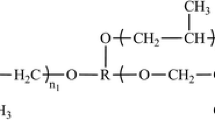Abstract
The thermal conductivity of rigid closed-cell polyurethane foams during long-term aging has been studied. The similarity between the kinetics of changes in the physical and mechanical characteristics of PU foams on progressive aging is established, which is attributed to the effect of matrix destruction. It is found that rigid foams have cell walls of various strength, whose impact on the kinetics of changes in the physical characteristics of the foams during long-term aging is ascertained. The results of predicting the thermal conductivity of PU foams by the method of temperature-time analogy and establishing the limits of its application are discussed. The research presented is of interest both in determining the foam durability and in replacing freons by alternative, ecologically less harmful blowing agents.
Similar content being viewed by others
References
A. G. Dementyev and O. G. Tarakanov, Structure and Properties of Foam Plastics [in Russian], Khimiya, Moscow (1983).
G. C. J. Bart, G. M. R. du Cause Nazelle, de, “Certification of thermal conductivity aging of PUR foam,” in: Proc. Polyurethanes World Congr., Netherlands (1991), pp. 75–80.
J. R. Shankland, “Blowing agent emission from insulation foams,” in: Proc. Polyurethane World Congr., Netherlands (1991) pp. 91–98.
F. J. Norton, “Thermal conductivity and life of polymer foams,” J. Cell. Plast., 3, No. 1, 23–36 (1967).
G. M. F. Jeffs and D. J. Sparrow, “Progress in the reduction and elimination of the use of CFC-s rigid polyurethane foam,” Cell. Polym.,9, No. 4, 253 (1990).
D. A. Brandreth and Ingersoll, “Acceleration aging of rigid polyurethane foam,” Europ. J. Cell. Plast.,3, 134 (1980).
A. G. Ostrogorsky and L. R. Glicksman, “Electrical analogy of gas diffusion in closed cell foams,” J. Cell. Plast.,24, No. 3, 215 (1988).
G. Roux and G. Tramblay, “Prediction of the long-term insulation value of PUR foams. The ACERMI Method,” Cell. Polym.,9, No. 4, 278–293 (1990).
A. Cunningham and D. J. Sparrow, “Rigid polyurethane foam. What makes it the most effective insulant,” Cell. Polym.,5, No. 5, 327–347 (1986).
G. W. Ball, W. G. Healey, and J. B. Partington, “The thermal conductivity of isocyanate-based rigid cellular plastics. Performance in practice,” The Europ. J. Cell. Plast.,1, No. 1, 50–63 (1978).
Magdalena Svanstrőm and Olle Remnas, “Deformation of the blowing agent distribution in rigid polyurethane foam,” J. Cell. Plast.,32, No. 3, 159–171 (1996).
J. A. King, D. D. Latham, and J. C. Ackley, “Relationship ofk-factor versus density for various appliance foam formulations containing next generation blowing agents,” J. Cell. Plast.,32, No. 7, 355–366 (1996).
A. G. Dementyev, “Degradation of foamed plastics under hydrostatic pressure,” Mekh. Kompoz. Mater., No. 6, 1103–1105 (1980).
A. G. Dementyev, T. K. Khlystalova, A. I. Demina, and P. A. Zinger, “Structural-physical properties of polyurethane foams with different blowing agents,” Vysokomol. Soed.,33A, No. 10, 2257–2266 (1991).
A. A. Berlin and F. A. Shutov, Foamed Polymers Based on Reactive Oligomers [in Russian] Nauka, Moscow (1978).
O. G. Tarakanov, I. V. Shamov, A. G. Dementyev, and G. I. Kagan (eds.), Methodical Instructions on the Methods of Physicomechanical Tests, Moscow (1984).
A. G. Dementyev, T. K. Khlystalova, and I. I. Mikheeva, “Diffusion and sorption of water vapors in foam polyurethane,” Vysokomol. Soed.,31A, No. 10, 2084–2088, (1989).
A. G. Dementyev, T. K. Khlystalova, and P. A. Zinger, “Diffusion of foaming agents and prediction of the characteristics of polyurethane foams during aging,” Mech. Compos. Mater.,29, No. 4, 418–423, (1993).
A. G. Dementyev, “Determination of porosity of rigid foam plastics,” Plast. Massy, No. 3, 70–71 (1969).
A. G. Dementyev and P. I. Seliverstov, “Determination of strength of cell walls of foam plastics,” Zavod. Lab., No. 4, 498–499 (1975).
A. G. Dementyev, O. G. Tarakanov, E. A. Gurov, V. A. Orlov, M. I. Prigozhin, and I. M. Prusakova, “Simulation of prediction functions in aging of rigid polyurethane foams in ground,” Vysokomol. Soed.,29B, No. 10, 769–772 (1987).
K. I. Cirule and E. A. Putninsh, “An estimate of gas penetration and its connection with the microstructure of rigid polyurethane foams,” in: Proc. 6th All-Union Conf. Mech. Polym. Compos. Mater., Zinatne, Riga (1986).
I. B. Dorofeeva and O. G. Tarakanov, “Strength of chemical bonds in basic fragments of macromolecules of polyurethanes,” Vysokomol. Soed.,27A, No. 3, 617–622 (1985).
A. G. Dementyev, D. P. Mironov, O. G. Tarakanov, E. A. Gurov, E. V. Belova, and B. A. Kalinin, “Thermooxidative destruction of rigid polyurethane foam,” Vysokomol. Soed.,20A, No. 3, 603–607 (1978).
A. G. Dementyev, L. V. Nevskii, O. G. Tarakanov, and E. V. Belova, “Kinetics of thermooxidative destruction of polyurethane foams,” Zh. Prikl. Khim.,53, No. 11, 2447–2452 (1980).
A. G. Dementyev, “Deformation of elastic polyurethanes with a bimodal cellular structure,” Mech. Compos. Mater.,32, No. 3, 227–232 (1996).
A. G. Dementyev, “Deformability and strength of foam plastics,” Mech. Compos. Mater., No. 2, 209–216 (1988).
Author information
Authors and Affiliations
Additional information
Translated from Mekhanika Kompozitnykh Materialov, Vol. 35, No. 2, pp. 187–198, March–April, 1999.
Rights and permissions
About this article
Cite this article
Dementyev, A.G., Dementyev, M.A., Zinger, P.A. et al. Effect of the cellular structure on thermal conductivity of rigid closed-cell foam polymers during long-term aging. Mech Compos Mater 35, 129–138 (1999). https://doi.org/10.1007/BF02257243
Received:
Revised:
Issue Date:
DOI: https://doi.org/10.1007/BF02257243




